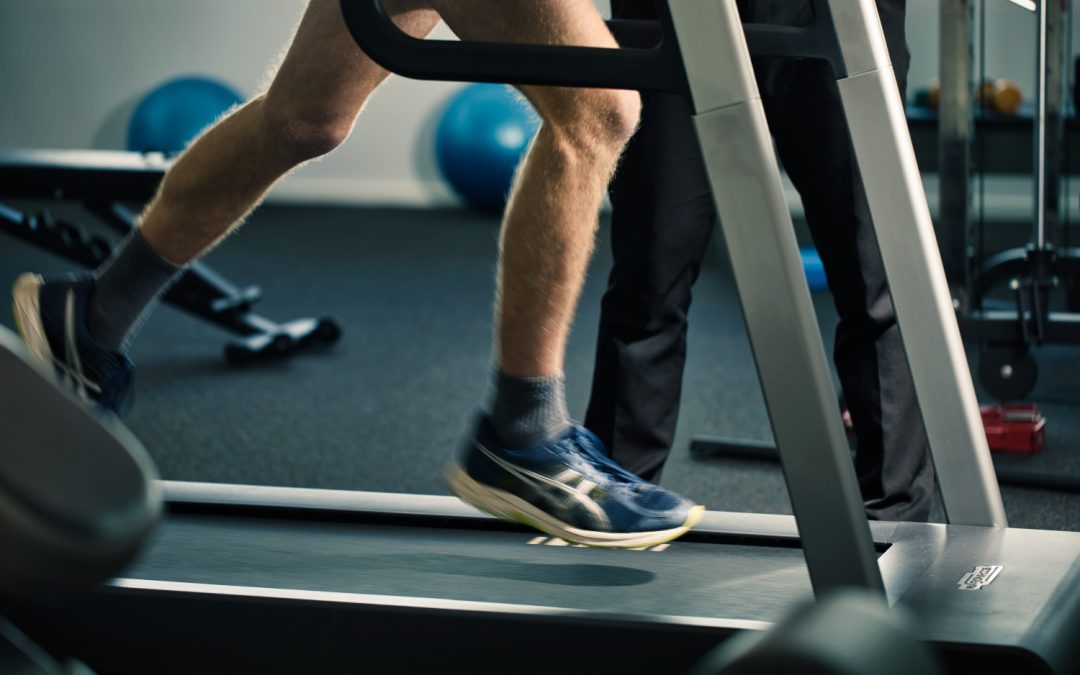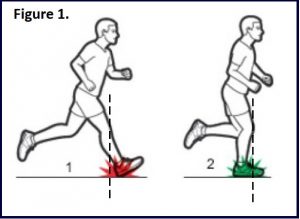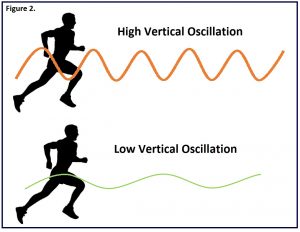Anybody can run, right? But if you are overcoming an injury or are looking to improve your running performance, should you look at your technique? Running, particularly distance running, is all about efficiency and economy. Being fit certainly helps, but if you’re the fittest person on earth yet still run like a duck you won’t win many races!
So what makes an efficient technique?
Efficient runners are effectively able to do two things:
- Minimise braking forces
- Optimise the use of elastic energy in their tendons
Minimising braking forces
Simply put, Braking forces are forces that stop you moving forward. The classic example is over-striding, where your foot contacts the ground in front of your knee (Figure 1).
As you can see in the picture above, the runner on the left contacts the ground with his foot in front of his knee, this will result in a large reaction force that will slow him down; he is effectively running with the brakes on. The runner on the right contacts the ground with his foot under a flexed knee, this allows his foot contact to be more of a glancing blow which won’t cut his momentum.
The other type of braking force comes from having a high vertical oscillation, which is the amount that you bob up and down when you run. Running is about moving forwards, not up and down! So as a general rule, the lower your vertical oscillation, the more efficient you’ll become (figure 2).
From a physio perspective, a lot of running-related injuries can be avoided or overcome by minimising these braking forces. Over-striding creates huge problems when running and can contribute to several different injuries including shin pain, patellofemoral pain, tendinopathy and even back pain. High vertical oscillation tends to cause stress related injuries, particularly shin pain (the further you jump up, the harder and faster you come down).
Optimise the elastic energy in your tendons
The other thing efficient runners do very well is utilise the elastic energy stored in their tendons to propel them forwards. When tendons are loaded, they stretch and recoil like a spring (figure 3). The stiffer the spring, the better the recoil. Imagine jumping on a pogo stick with an old, soft spring at the base – you won’t jump far with that. But, if you put a brand new, shiny, stiff spring on it, all of a sudden you will get a lot more propulsion.
When running at a constant pace, the muscles job is to contract and stiffen the tendon, making it more effective at utilising the stored energy.
So essentially you want to create stiffer ‘springs’ to run faster. There are several ways to do this:
- Running often and on different surfaces – Running requires high levels of motor control and coordination. Running on grass/sand/concrete/uphill/downhill all require subtle changes in muscle timing. So by practising on different surfaces your body will automatically begin to refine the timing and coordination, so the muscles contract to stiffen the tendons at the right time.
- Running Drills – their purpose is to refine the muscle timing and coordination of your running technique.
- Strength training – heavy resistance training not only strengthens muscles, over time it will increase tendon stiffness…very helpful, and very underrated.
- Plyometrics – these are high intensity activities such as jumping and hopping which are designed to train you body to use the elastic energy in your tendons. They can be useful but they are quite intense so you need to have an adequate strength otherwise you can cause an injury.
So is running technique important? Bloody Oath! Remember, anybody can run, but we can always improve!
Peak Sports Physiotherapy offers comprehensive running assessments and individualised programs to help you improve your running performance and reduce your risk of injury. For more information, please call 03 5721 4162 or book an appointment online.
Cheers,
Todd Bird
Peak Sports Physiotherapy




